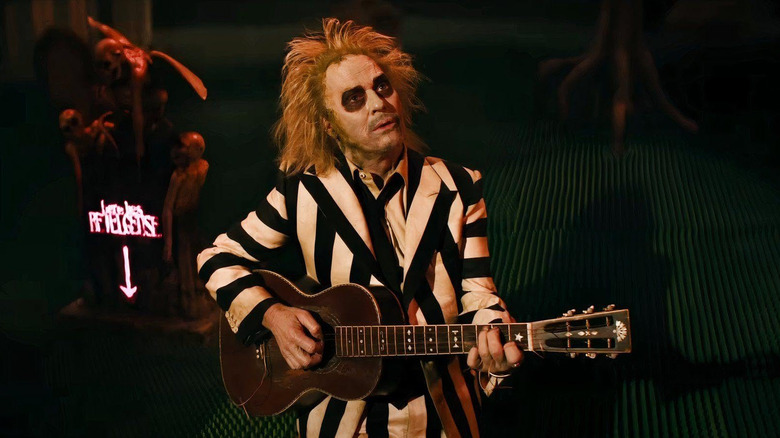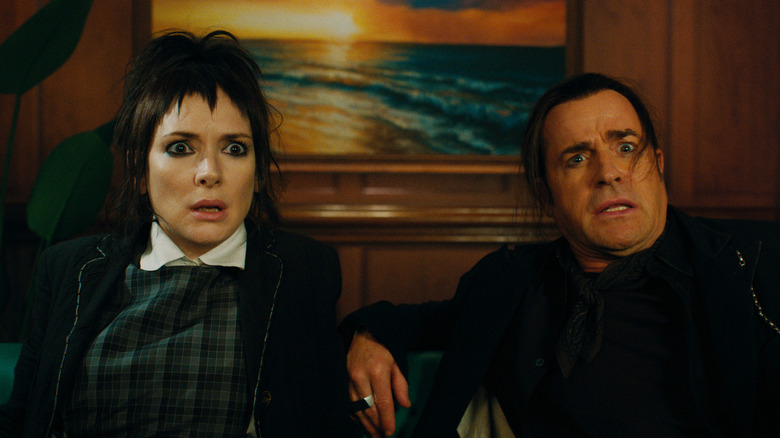Beetlejuice Beetlejuice's Wildest Creature Was A True DIY Project
Heavy spoilers ahead for "Beetlejuice Beetlejuice."
"Beetlejuice Beetlejuice" is a gonzo sequel to an '80s masterpiece. It's also the best movie Tim Burton has made in over a decade — one that's filled with spectacular art direction, designs, and practical effects.
One big standout aspect of "Beetlejuice Beetlejuice" comes right after Michael Keaton's Beetlejuice is reunited with Winona Ryder's Lydia Deetz after decades of stalking her. Hoping to romantically win her back, he merely points at her and she becomes instantaneously pregnant — literally — and in a matter of seconds, her water breaks and an actual baby drops to the floor. It's one of the grossest things put to screen in a major motion picture this year, on par with the grotesque and graphic birth scenes in "Immaculate" and "The First Omen" but on a PG-13 rating.
As if the birth of the creature isn't enough, the newborn spawn looks up and ... it's literally a mini-Beetlejuice with white hair and messed-up, dead eyes. Immediately, the little monster starts crawling up the ceiling as though it's possessed by Pazuzu and biting Lydia in her leg before Beetlejuice kicks it like a football. Like most things in the movie, the baby was a practical creature created by a team led by creature effects creative supervisor Neal Scanlan. During a press event attended by /Film's Jacob Hall, director Tim Burton spoke about the creation of the most horrifying baby of 2024.
"We went to a toy store and bought some dolls and cut them up," Burton said. "See, this was the fun of making the movie. We obviously sculpted the thing, but we truly took basically a baby from the store and put some wires on it and moved it around."
"It was important all the way through that that was one of the sort of rules engagement," Burton continued, referring to the use of practical effects in the movie (echoing the practicality of the original movie).
Practical effects make Beetlejuice unique
The use of practical effects, and even the pursuit of making the visual effects look like they were made practically — with imperfection, done by hand — is a big part of what makes "Beetlejuice Beetlejuice" so unique, doubly so because so many of Burton's recent movies have abandoned this practice. In an interview with our own Jacob Hall, co-star Justin Theroux talked about his experience working with the practical creatures and effects in the movie, praising the Beetlejuice baby in particular.
"I had never worked, I don't think, with puppets or animatronics, and that was really fun to be able to work with. For example, that Beetlejuice baby was an incredible piece of not just art, but also machinery and engineering. That caught me off guard just how fascinated I was by that. And then just all this blood and guts, rubber, latex and goo stuff was just fun because when, for example, when he rips open a sweater and that blows all over me and Lydia, it really requires very little acting, just react to that because it's such a fun gag."
As a gag, the baby works because it's exactly the kind of gross harassment disguised as a joke that Beetlejuice would have done in the first movie. Despite what Warner Bros. and theme parks would want you to believe, Beetlejuice as a character is not a kid-friendly character worthy of a cute Saturday morning cartoon, but instead a despicable, disgusting creep that got his edges sanded off like many other popular '80s characters. Indeed, the one thing that makes "Beetlejuice Beetlejuice" work is that the titular character doesn't change or evolve, but instead remains as he always was. Many legacy sequels have their original characters remain static even decades after the original, like "Top Gun: Maverick" or "The Force Awakens." In the case of Beetlejuice, however, his remaining unchanged fits perfectly.
"Beetlejuice Beetlejuice" is now playing in theaters.

